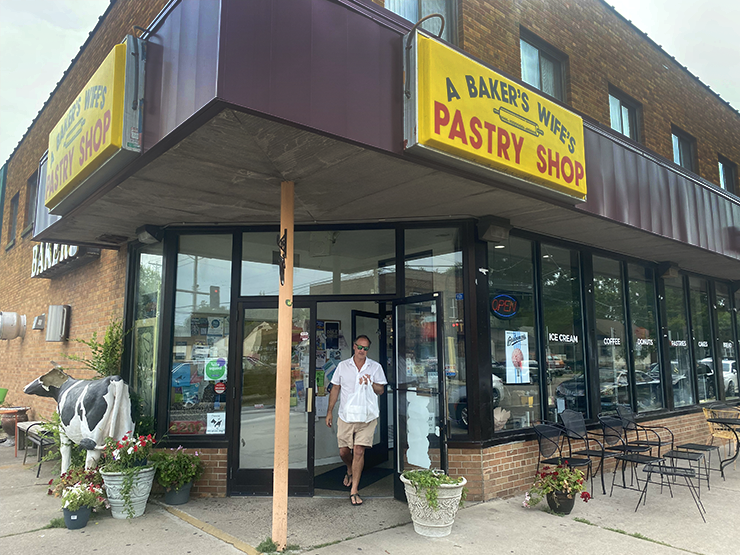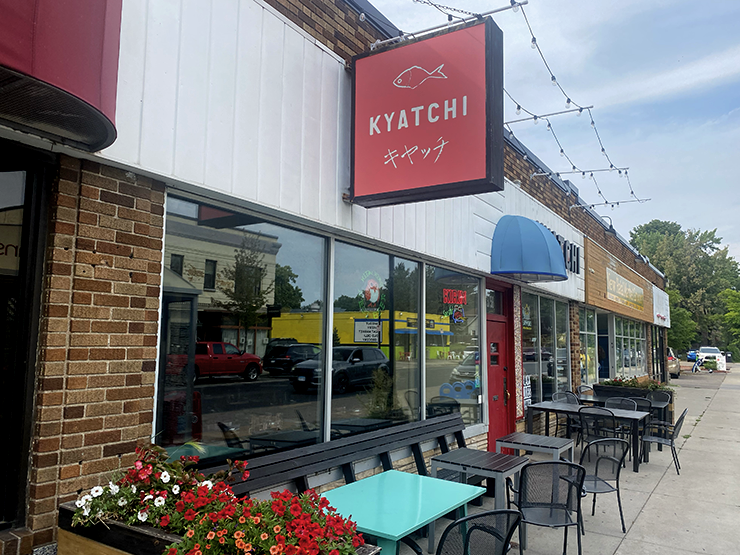Everyone knows about the “warehouse district” in downtown Minneapolis or the Theater District on Hennepin Avenue. But elsewhere in the Twin Cities, there are slimmer pickings for hyperlocal concentration. I’d like to change that. Now that I’ve sketched out a “patio district” on St. Paul’s Selby Avenue, let’s dive a little deeper into exploring parts of town that, for one reason or another, have accumulated more than their fair share of a certain type of shop.
For one thing, any good city has districts. For example, global cities have “diamond districts” or “gold districts,” where everyone interested in rings or retail finds themselves. Big cities have “financial districts,” where banks and brokers flock. The Bowery in New York has three solid blocks of stores that sell restaurant supply equipment, all right in a row. Tokyo’s Golden Gai has more tiny bars per square foot than anywhere else on Earth.
In urban geography terms, this is called “agglomeration,” the tendency of similar enterprises to clump together. This happens for different reasons, including local demand, as when late-night pizza places open in Dinkytown. Sometimes it’s for reasons of legibility, to be closer to where customers and suppliers expect you to be. Sometimes it’s spite that causes intra-block competition, as with classic food schisms like American and Lafayette coney dogs in downtown Detroit, or Geno’s and Pat’s cheesesteaks in South Philadelphia.
In other words, for one reason or another, like tends to stick with like, and that’s how districts are born. Here are five of the more obscure districts in Minneapolis.
The Ice Cream District
If you want to find fancy ice cream, look no farther than “the Wedge”, aka Minneapolis’ Ice Cream District. This is the pie slice-shaped neighborhood spread between Lyndale and Hennepin avenues, and it’s where, all through the summer, you’ll find the sidewalks paved with drops of melting cones. Most famously, there are Sebastian Joe’s and Milkjam Creamery on Franklin and Lyndale Avenues, respectively. Each has its converts, and as with many decisions in the Ice Cream District, you cannot go wrong.
Sebastian Joe’s claims a 30-year heritage in South Minneapolis, while Milkjam has only been scooping cones since 2016. In both cases, the quality is top notch. At just about a half-mile away from each other, you could order a cone from one, and by the time you finish it, arrive at the other.
That’s not all. Within the Minneapolis Ice Cream District, you’ll also find Sonny’s Ice Cream Café at 34th and Lyndale, La La Homemade Ice Cream and Luncheonette at 31st and Hennepin, and newcomer Bebe Zito Ice Cream at 22nd and Lyndale. Why so many in one part of town? I can only assume that seeing someone eating an ice cream cone makes for great “eye-to-mouth” advertising. Summer in the Wedge is all the sweeter thanks to its happy correspondence with the Ice Cream District.
The Karaoke District
There are plenty of places in town to sing karaoke, but three rise above the fray to achieve legendary status, and they’re all nestled in Northeast Minneapolis. Forming a triangle between Broadway and Central Avenues, the Karaoke District is anchored by The Vegas Lounge, whose small stage is masterfully emcee’d each night by only the most veteran hosts. There’s no more celebrated place to belt classic ‘80s jams. If you’re good enough, the whole bar sings along.
Less than a mile to the west, the 1029 Bar (original home to the Smack Shack lobster roll) hosts a vaunted karaoke session four nights a week that draws people from all over the metro.
Completing the out-of-tune triangle, the tiny Otter Saloon on Central Avenue has long been the city’s most intimate place to embarrass yourself nightly. Walking into the bar during someone’s performance, you’re practically on the stage, with nowhere to hide in the tiny wedge-shaped room. While there are plenty of places for good karaoke in town, the Karaoke District brings it to the next level.

The Donut District
For some reason, all the classic Minneapolis donut shops can all be found in the same quiet part of South Minneapolis, roughly clustered around lakes Hiawatha and Nokomis. That’s where you’ll discover the Mel-O-Glaze bakery, which has anchored Minneapolis’ blossoming “Donut District” for over 70 years. Within a mile-radius, three great donut bakeries thrive. I imagine that at each establishment, people work through the wee hours to bring donuts to the morning masses. Maybe they pass each other on 28th Avenue in the night, on their way to clock in.
Mel-O-Glaze is rightly famed for their classic glazer, and only five blocks away, the city’s best cake donut can be found at the Baker’s Wife (technically “Baker’s Wife’s Pastry Shop”). It opened in 1996, when a former pastry chef who once worked New York City’s Plaza Hotel, opened his own place on Minneapolis’ 42nd Street. (I remain unsure if it was attracted by the donut proximity to Mel-O-Glaze, or was it a delicious coincidence?)

Canadian-themed Bar District (Defunct)
Keen-eyed observers might notice a pair of buildings across the street from each other in Cedar-Riverside’s chaotic intersection of Washington and Cedar Avenues. Here there’s an odd confluence of saloon history involving the for-sale Republic Bar (RIP), which closed during the pandemic. Before it was the Republic, it was Sgt. Preston’s Bar from the mid 1970s until about 2010, named to honor a 1950s TV show called “Sergeant Preston of the Yukon.” To this day, you’ll find inside stained glass windows depicting the official flowers of the various Canadian provinces (e.g. the wild rose of Alberta), which is a strange sight.
Weirdly, kitty-corner across the street sits another nearly abandoned bar, Bullwinkle’s, named after the cartoon moose that was wildly popular in the early 1960s. (Surely, this name means nothing to today’s University students, born well into the 21st century?) Trivia fans might realize that Bullwinkle was, in lore, closely friends with Dudley Do-Right, a Canadian Mountie (aka RCMP, federal police). The close proximity of these two vaguely Canadian Mountie-connected bars, now abandoned but still bearing their far northern marks, has always delighted me.
For a while, when the legendary Triple Rock Social Club (RIP) down the street hosted a regular special on poutine, Canadian culture was thriving on the West Bank in a way that made no sense.
Ramen District
More famous soup neighborhoods surely exist, like St. Paul’s phở corridor along University Avenue, but if you’re looking for great ramen, the area around Nicollet Avenue and Lake Street punches above its weight class. This is South Minneapolis’ nascent Ramen District, anchored by a quartet of excellent ramen joints: Ramen Kazama, Moto-I, Kyatchi, and newcomer Ramen Shoten.
While there are other great ramen shops around the city, the Lyn-Lake and Eat Street area have staked a claim to the district title. Moto-I has been around since 2008, and not only do they make their own sake, but you can sip a bowl of ramen on a rooftop, which is an astounding experience. Ramen Kazama was started by local punk legend, Matthew Kazama (of the band Birthday Suits), and the noodle joint has been thriving for years. Just a few blocks down Nicollet Avenue, Kyatchi (Japanese English for the word “catch”) has an even stranger origin story. Its founder, Hide Tozawa, was personal chef to professional baseball players like Hisashi Iwakuma (pitcher for the Seattle Mariners) and Tsuyoshi Nishioka (ever-so-briefly, the starting second baseman for the Twins). While more of a sushi joint, their ramen is superb. Meanwhile, the district’s newcomer, Ramen Shoten, offers a true lunch counter experience farther up Nicollet in the new Eat Street Social food hall. I suppose we could call it “Slurp Street.”



0 Commentaires